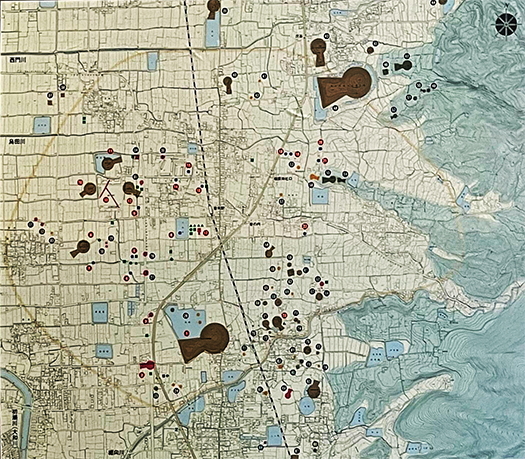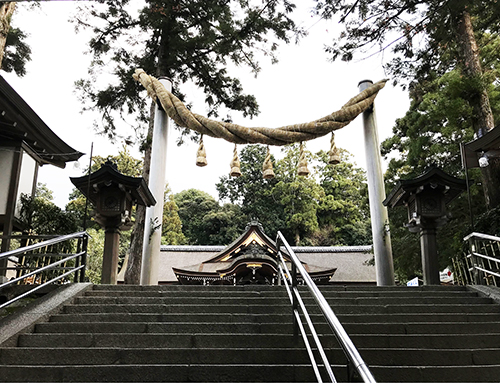

桜井市立埋蔵文化財センターでの展示パネルの一文要旨。
〜<マキムクの時代>
弥生時代を通じて活発な活動が繰り広げられていた拠点集落では、
2世紀末から3世紀初頭になると環濠が埋め立てられ、
集落の規模も小さくハッキリしなくなることがわかっています。
このような集落構造の変化は、それまでの弥生社会の枠組みが崩れたことを
あらわすとともに、新たな古墳時代の幕開けを告げると考えられています。
●弥生集落が衰退・廃絶に向かうちょうどその頃、
これらと入れ替わりに出現するのが纏向遺跡です。●
土器の形式では庄内0式期(3世紀初頭)と呼ばれる時期に当たり、
弥生時代には集落が無かった場所に突如として径約1kmという
巨大な「マチ」が出現したのです。
それはそれまでの農耕的色彩の強い弥生時代集落のような自然発生的な
ものではなく、きわめて強い政治的な意図のもとに作り上げられた
「マチ」であると考えられています。〜
おお、であります。
少なくとも考古的発掘事実からはこのような推論が確定している、と。
そしてそうした事跡は記紀の記述では10代崇神帝に擬せられるという。
以下、Wikiの「崇神天皇」の条から要旨引用。
〜即位3年、三輪山西麓の瑞籬宮(みずかきのみや)に都を移した。
即位5年、疫病が流行し人口の半ばが失われた。祭祀で疫病を治めようとした天皇は
翌年に天照大神と倭大国魂神を宮中の外に出すことにした。
天照大神は豊鍬入姫命に託し(現在の三輪山麓の)檜原神社に祀らせた。
即位7年「朕の世になり災害が多い。亀卜にて見極めよう」と詔して、
八百万神を集めて占った。すると倭迹迹日百襲姫命に大物主神が乗り移って
自分を祀るよう託宣した。そのままに祭祀を行ったが霊験がなかった。
そこで天皇は沐浴斎戒し「願わくば夢に教えて神恩を示してほしい」
と祈った。するとその夜の夢に一人の貴人が現れ自ら大物主神と称して
「もし我が子の大田田根子を以って我を祭れば平安となる」と告げた。
そこで大物主神の子孫・大田田根子が探し出され大物主神を祭る神主となった。
三輪山を神体とする大神神社の創始。すると疫病は終息し五穀豊穣となった。〜


2世紀末から3世紀初頭という年代は飛鳥時代からは200年以上前。
また文中にある「倭迹迹日百襲姫命」とは箸墓古墳の被葬者。
また、大物主神とは出雲系の国造りの神・大国主神の異称とされる。
このような記紀の記述と考古的発掘成果を踏まえれば、
この纏向遺跡は、飛鳥以前の王都の痕跡であると考えられて不思議ではない。
住宅をライフワークにしてきた人間としては日本の「マチ」始原説は、響く。
飛鳥宮ですら深い迷宮のように思えていたことからすると
その底深さに慄くばかりではありますが、いまのところ
こうした推論について否定しうる根拠を見いだせないでいます。
歴史のひとつの興味深い推論だと思わせられますね。・・・
English version⬇
Kingship that came to “Makimuku” at the foot of Mt. Miwa, Yamato Historical Testimony-12
In the 10th Emperor Sujin’s relics, he “moved the capital to the western foot of Miwa Mountain. He founded the Izumo-derived Ookami Shrine in hopes of remedying plague and disease. Fusion of myth and archaeological excavation. The fusion of mythology and archaeological excavation.
Abstract of a sentence from an exhibition panel at the Sakurai Municipal Center for Archaeological and Cultural Properties.
~The Makimuku Period
The base village, which had been active throughout the Yayoi period, was filled up with a moat encircling the village from the late 2nd to the early 3rd century.
In the late 2nd to early 3rd century, the moat encircling the village was filled in, and the size of the settlement became smaller and less clearly defined.
In the late 2nd to early 3rd century, the moat encircling the settlement was filled in, and the settlement scale became small and indistinct.
Such a change in settlement structure indicates that the framework of Yayoi society had collapsed.
This change in settlement structure is thought to indicate the collapse of the previous framework of Yayoi society and the beginning of a new Kofun period.
Just as the Yayoi settlements were beginning to decline and die out, the Kofun period was beginning to emerge in their place.
The Makimuku ruins appeared in place of the Yayoi settlements that were declining and dying out. The pottery type is Shonai 0.
The pottery forms of the site correspond to the Shonai 0-period (early 3rd century), which is considered to mark the beginning of the Yayoi period.
A huge “Machi” of about 1 km in diameter suddenly appeared in a place where there had been no settlements in the Yayoi period.
A huge “Machi” of about 1 km in diameter suddenly appeared in a place where there had been no settlements in the Yayoi period.
It was not a spontaneous emergence like the settlements of the Yayoi period, which had a strong agricultural flavor, but rather an extremely strong political intention.
but rather a “Machi” that was created with a very strong political agenda.
It is believed to be a “Machi” created with a very strong political agenda. 〜Oh.
Oh, yes.
At least, such an inference is confirmed by archaeological excavations.
And the Chronicler’s description of such an event is said to be the 10th emperor of the Chronicles.
The following is a summary quote from the article “Emperor Sojin” in Wiki.
〜In the third year of his reign, he moved his capital to the palace of Mizukakinomiya at the western foot of Miwa Mountain.
In the 5th year of his accession, an epidemic caused the loss of half of the population. The emperor tried to cure the plague with rituals.
The following year, he decided to remove the deities Amaterasu and Wakatonokotama from the palace.
He entrusted Amaterasu to Toyohuenirihime no Mikoto and had her enshrined at Hinohara Shrine (at the foot of present-day Miwa Mountain).
In the 7th year of his accession to the throne, he said, “In my reign, there have been many disasters. I shall use kameutsu (divination by tortoises) to determine the cause.
He gathered the eight million gods and divined their fortunes. Then, the deity Omononushi took over and enshrined himself in the deity.
and commanded that he be worshipped. He performed the ritual as it was, but it did not produce any miraculous results.
The emperor then bathed and prayed, “I wish you would teach me in my dreams and show me the favor of the gods.
The emperor bathed and prayed, “I wish you would show me your divine favor in my dreams. Then, in a dream that night, a nobleman appeared to him, calling himself the deity Omotonushi.
If you worship me with my son Otadaneko, you will be at peace.
Ootadeneko, a descendant of Omotonushi, was found and became the deity who worshipped Omotonushi.
He became the founder of Ogami-no-sha Shrine, with Mount Miwa as its sacred body. The plague ended and the harvest was bountiful. 〜From the end of the 2nd to the beginning of the 3rd century
The late 2nd to early 3rd century is more than 200 years before the Asuka period.
The “Wajaku-no-Hyakuso no Mikoto” in the text refers to a person buried in the tomb of Chopstick Tomb.
Also, “Ohmononushi” is said to be a variant of “Okuninushi,” the god of nation-building of the Izumo lineage.
Based on the descriptions in the Chronicles and the archaeological findings, the
It is not surprising that the Makimuku site is thought to be a trace of a pre-Asuka royal capital.
As a person who has made housing his life’s work, the theory of the origin of “Machi” in Japan resonates with me.
Given the fact that even the Asuka Palace seemed like a deep labyrinth
I can only shudder at the depths of the labyrinth, but at the moment I have no
I have not been able to find any evidence to deny this theory.
It is an interesting theory of history. The fusion of mythology and archaeological excavation.
Posted on 7月 3rd, 2022 by 三木 奎吾
Filed under: 住宅マーケティング, 歴史探訪







コメントを投稿
「※誹謗中傷や、悪意のある書き込み、営利目的などのコメントを防ぐために、投稿された全てのコメントは一時的に保留されますのでご了承ください。」
You must be logged in to post a comment.